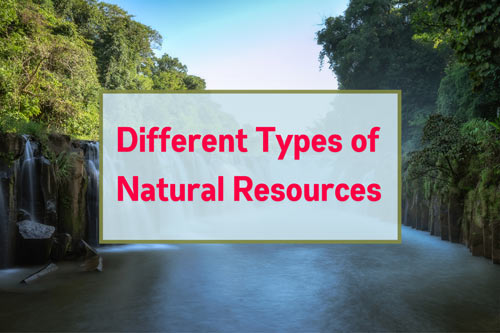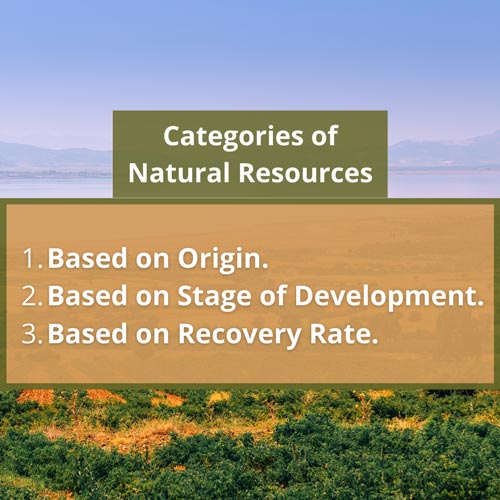What Are the Types of Natural Resources?
Everyone who is reading this article now is well accustomed to the word Natural Resources, its types, its value, and the current situation it’s facing.
Table of Contents
What Are Natural Resources?
Natural resources refer to that resource that is generated or was generated without any actions of humankind. They are naturally occurring materials that are useful to humans or could be useful under conceivable economic, technological, or social situations.
On Earth what constitutes Natural resources?
- It’s the Sunlight.
- The atmosphere around us.
- The water of all sorts.
- Land, including barren lands or soil.
- Vegetation and human life.
Natural resources exist as separate entity namely, freshwater, air, living organisms. Now along with all the above, there is the certain material form of natural resources, some of them are set down below:
- Metal ores – Cinnabar, ore of mercury, ZnS, zinc, and many more.
- Rare Earth elements – They are also referred to as Rare Earth oxides or Lanthanides. There are usually a set of 17 indistinguishable lustrous silvery-white soft heavy metals.
- Petroleum – Refers to crude oil also and is naturally occurring. It is the yellow-blackish liquid found in geological forms. It is defined as fuels.
- Energy – A quantitative property that must be moved/transferred to an object to perform work on, or to heat.
Different Types of Natural Resources
Categories of natural resources have a diverse range. They are further divided into subcategories.
- Based on Origin.
- Based on Stage of Development.
- Natural Resources Based on Recovery Rate.
Natural Resources Based on Origin
These natural resources are further divided into two forms, namely Biotic and Abiotic resources with examples:
Biotic Resources:
It can be defined as a living component that places an effect on another organism or shapes the ecosystem. Biotic factors include human influence, disease outbreaks, and pathogens.
Each biotic factor requires the right amount of nutrition and energy to function properly. They are capable of reproduction. Fossil fuels are also included in this category because of their formation from decayed organic matter. Examples of biotic resources- Birds, plants, fungi, human beings, and other similar organisms.
Abiotic Resources:
This type of resource comes from non-living organisms or non-organic materials. They are referred to as the physical part of the environment that affects the living organisms and the function of ecosystems.
Association and formation of abiotic resources underpin biology of its own. These components include physical condition. The degradation of this kind occurs by chemical or physical processes. They are usually obtained from the lithosphere, atmosphere, and hydrosphere. Examples of abiotic resources- water, air, soil, sunlight, minerals.
Natural Resources Based on Stage of Development
These types of natural resources based on the stage of development are further divided into four forms with examples, namely:
Potential Resources:
This kind of resource can be reused in the future. Resources that are available in the region but are not fully used. They are not fully used because of a lack of investment or any other of a similar kind. Examples of potential resources – petroleum in sedimentary rocks until drilled out and put to use remain potential resources.
Actual Resources:
They are referred to as the resources whose quantity is known and this kind is being used in present. Most of them have been surveyed and their quantity and quality have been determined. Examples of actual resources – coal, water, petrol, Uranium in Ladakh.
Reserve Resources:
They form a part of actual resources that can be developed profitably in the future. We don’t extract the resources at present and are kept to meet the future requirement of the world. Example of Reserve resources – Storage of water in the dam for energy requirement.
Stock Resources:
This kind has been surveyed but can’t be used due to a lack of technology. Their quantity is usually expressed in absolute amounts rather than in rates and can be enduringly expended. Example of stock resources – Hydrogen.
Natural Resources Based on Recovery Rate
These kinds of natural resources based on recovery rate are further divided into two resources, namely: Renewable and Non-Renewable resources:
Renewable Resources:
These kinds of resources are replenished naturally and are continuously available for human consumption. They do not have rapid recovery rates therefore they are susceptible to depletion by over-use.
Now, resources from the human mind perspective are said to be renewable so long as the rate of recovery exceeds the rate of consumption. The demand for natural resources is increasing as the human population continues to grow.
Also, energy generated from this kind of resources put less amount of strain on the limited supply of resources that are considered non-renewable. We have to be cost-effective while using renewable resources.
Incentives are designed in huge numbers so that people work on an alternative basis. Green funds invest in vehicles that are eco-friendly. Examples of renewable resources are – Sunlight, air, wind, water.
Non-renewable Resources:
These kinds of resources do not occur naturally in the environment or either takes a long time the form. Again, from our perspective resources are said to be non-renewable when the consumption rate exceeds the recovery rate of the same. Some of the non-renewable resources take decades to grow.
Once non-renewable resources are used up, they cannot be replaced which acts as a major problem to human mankind. Our society depends largely on non-renewable resources as its primary sources of energy.
Fossil fuel is now considered a non-renewable resource because of its continuous consumption and it takes a huge amount of time to replenish. We depend on fossil fuels because they are rich in energy and relatively cheap to process. Examples of non-renewable resources are – Fossil fuel, Coal, natural gas, phosphate, uranium, tar sand, etc.
In the end, we can say all types of natural resources are important and management of natural resources is the essential thing to follow. We have to save them as much as possible for future generations.

